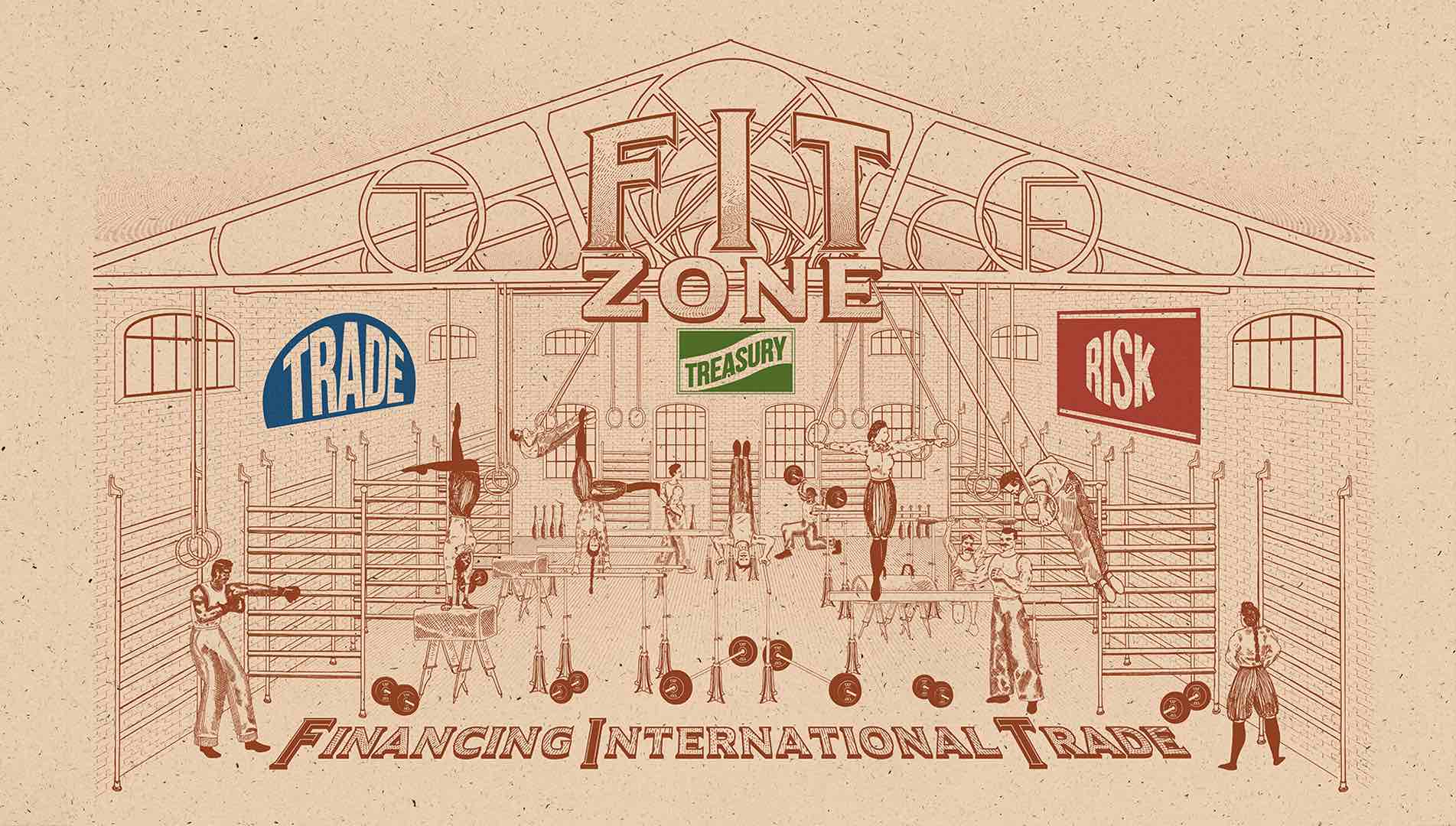
A call for action. We spoke to Katharine Morton, Head of Trade, Treasury and Risk at TXF on how to get FIT for trade, treasury and risk (without any physical exercise)

FIT for TXF is taking on a whole new meaning. Financing International Trade (FIT) is a workout in three core areas: trade, treasury and risk. TXF is bringing together its coverage of trade, treasury and risk in one place in the FIT Zone. Why? Because these three can no longer be looked at in silos.
Here’s a taste of what’s to come.
The long term is a series of (very) short terms
It’s easy to get bogged down in the mire of defining trade finance, but in trade, the long term is a series of short terms. And financing international trade doesn’t stop with the short term, whether that flow of trade is building a power station or ordering shoes with pink bows online.
Supply chains are changing, in many cases shortening, while payments chains are often lengthening as a result of derisking correspondent banking relationships. Regulation is having profound effects, many of them unintended. The way we look at financing international trade, the language we use, the way we think about financing business, needs to change too. Trade without traditional trade finance is evolving.
Banks don’t want to take as much of the risk of funding trade on their balance sheets. That’s because of Basel II and III and even the hypothetical IV. They’re disappointed that regulators haven’t taken on board that the very point of traditional documentary trade finance instruments was to cut risk and haven’t given trade finance the ‘low risk’ treatment when they calculate risk weightings on the balance sheet and their calculations on capital adequacy. The difficulty too is that those low risk calculations for trade don’t quantify the non-financial risks of trade finance. Going forward with the Basel process, banks are likely to have to deal with what they perceive as regulatory intransigence and resign themselves to the possibility that the Basel process won’t lighten the treatment of trade.
“If banks don’t get with the programme and embrace and help make a difference, banks won’t be providing trade finance as part of their offering for much longer,” says Mark Evans, managing director of transaction banking at ANZ. “The need for finance is always going to be there – but if the regulators don’t trust us and push us down the path [where documentary trade is no longer cost efficient and all banks do for corporates is fund working capital without seeing the underlying asset, it’s a problem]. We need to regain trust and collaborate with regulators so we can collectively work together to improve the safety and resilience of the financial system, helping to catch the bad guys.”
Doing proportionately less trade finance does mean that banks are going to have less visibility of the underlying flows of international trade. Windows are opening for other players, such as Fintechs, but the gap is still wide. It also means that some banks are keen to offload (sell down, distribute) more of their trade assets and to encourage the development of trade as an asset class.
Why FIT for trade, treasury and risk?
FIT for trade
Peter Hazou, who is director, business development, financial services at Microsoft, talks about marrying the physical and financial side of supply chains.
“One of the problems with trade finance is that it is framed around the tradition of big stuff from the commodity end. [It then goes] right down through moving boxes as trade finance at a certain scale,” he says.
“But if you think about it as international commerce as opposed to international trade, and not get stuck with the framework of just trade finance – documentary, letters of credit, etc. Looking it as financing international commerce is the right perspective today.”
Interestingly enough, commerce and trade are interchangeable as terms in the dictionaries of many countries. The US has a department of commerce, the UK a Department for International Trade, and the French a department of the external (foreign) commerce, dependent on your translator.
Hazou continues: “So much is accessible that needs financing, whether it is suppliers in the supply chain. Today’s market demands a much broader view than a narrow perspective of a multinational sourcing from strategic suppliers.”
Maybe it needs a complete shift in terminology but companies doing business across borders need information on how best to do it, how they fund it in the best way and to be able to cut through the perceived opacity of traditional trade finance. Open account trading now dominates international trade, but that is far from risk free.
FIT for treasury
Corporate treasurers can be forgiven for not caring how payments arrive or leave as long as those payments are right – and they come and go from the right counterparties.
Integrating trade, treasury and risk might make sense in an ideal world. The challenge for corporates [and we should remind banks at this point that they are there to help in this] is to communicate across all departments so that from sales to procurement to global operating units reporting up the pyramid to the CFO that they understand the consequences of properly managing trade finance. Treasury’s role as a nexus of understanding and communicating risk is central.
But as a box of tools ‘trade finance’ has been perceived by both banks and companies as a backwater of paper and process, not part of strategic integrated treasury. With open account trading becoming a norm and the development of e-invoicing and other digital technology, and refinements in risk management, the discussion about how trade is financed needs to evolve. Financing international commerce runs straight from efficient cash and treasury management, working capital and supply chain finance across borders right through to documentary trade finance.
Supply chain finance (SCF) is being hailed as a key way for corporate treasurers to support financing of international trade across their supply chains. But you only have to look at Carillion and Moody’s March report to see that the extent to which reverse factoring and other forms of receivables finance are going to be more under the spotlight in terms of their balance sheet and accounting treatment. There’s so much to talk about.
FIT for risk is vital. Being able to price risk appropriately along supply chains is changing fast. Trade finance is one of many ways there is to cut, or alleviate, the risks that arise from transactions across borders.
The basic risk of international trade is the same as that of domestic trade. It is the risk of non-payment. But it is complicated by longer terms, currency fluctuations and the need for increased financial support – such as lines of credit, credit enhancement and special guarantees.
Trade credit insurance is evolving too. With banks offloading trade finance assets, partnerships with people who mitigate risk (insurers) are becoming more visible, and in some cases trade credit insurers are also embracing technology to digitise trade credit offerings.
And trade itself as an asset class should be welcomed in a time of still low yields. This development is being facilitated in some areas by the embracement of technology as a way to help improve secondary market liquidity and create securities that can be cleared and settled. However, there is still a need for education for investors, for more sensitive and dynamic ratings procedures (implied or otherwise) and visibility and clarity on pricing secondary markets to see what yields trade assets can give. It’s all happening. Again, much to talk about.
There remain challenges in the path of developing trade as an asset class for buyers other than other banks, though. Says Evans at ANZ: “It’s not an easy asset for investors to get their heads around. They start to understand, then waiver when they have to consider trade documentation/fraud/commercial risks. It’s not always ‘clean’ enough in their eyes or leaves them or their accountants uncomfortable if it is not hypothetically completely without recourse. Even the letter of credit (LC) is still subject to fraud or commercial dispute. Insurers and some investors have an appetite but the market is not moving as fast as people will have you believe.”
What can facilitate trade business, digital and traditional?
“There are so many different elements that go into financing international trade – some are traditional such as risk mitigation that has documentary requirements – you still have customs, etc. but so many need more open platforms and the internet. What can facilitate trade commerce, rather than just trade finance, is the right framework to address this,” Microsoft’s Hazou continues.
That’s not to abandon documentary business. It’s very easy to knock what should still be the most effective ways of financing international trade in a risk-appropriate way. Technology is, in part, helping reshape financing trade – albeit more slowly in some areas than many expect.
“There are so many technologies that are making documentary trade easier,” Hazou says, “such as real-time analytics. Analytics is so important for risk mitigation, for financing, for supplier risk, logistical risk. All these elements of data provide huge insights to improving [the view of risk and mitigating it].”
Developments with blockchain will inevitably have to be monitored. It’s important not to get blinded by it, but the evolution of smart contracts will have wider effects for financing international trade in terms of ensuring authenticity, transparency and speed. The issue remains how to scale it across whole trading supply chains. As Hazou says: “The network effect is necessary. Having one fax machine is no good.”
It’s an interesting time to be creating a best practice zone to discuss things that are useful to see or hear about for one of the oldest new subjects there is. We hope you’ll join us on TXF’s FIT journey– it’s going to be a fun (bumpy!) ride. Members of the FIT Zone will be able to read features, interviews, expert briefings, join discussions and webinars, hear podcasts and watch videos in this fast evolving area.






























